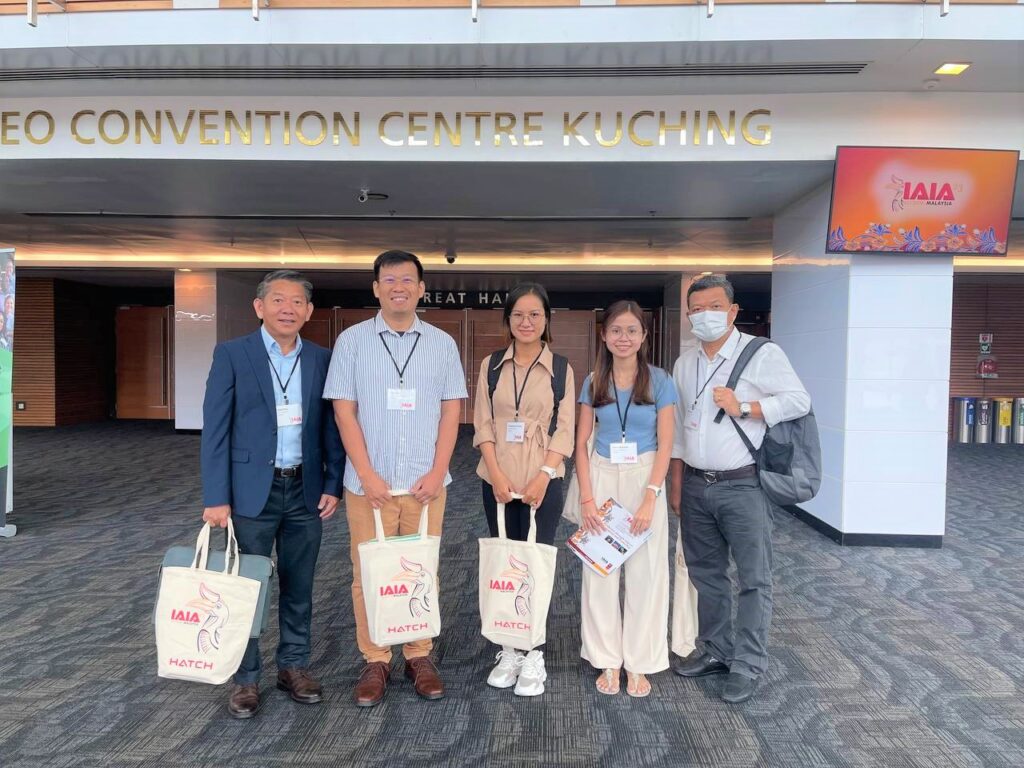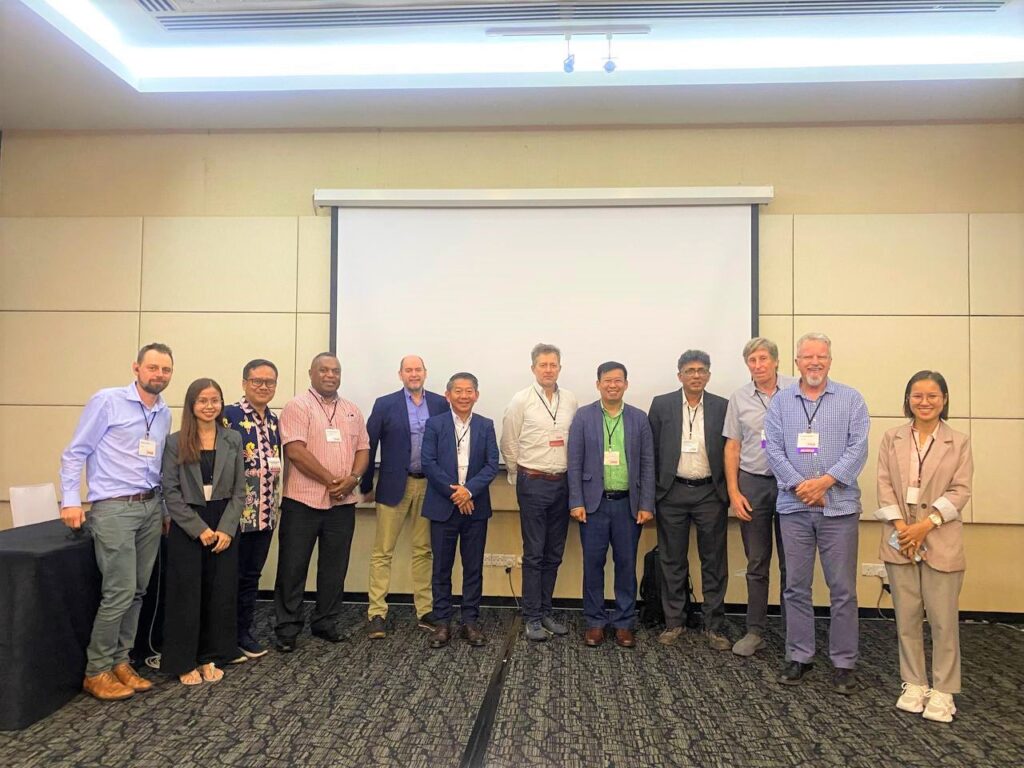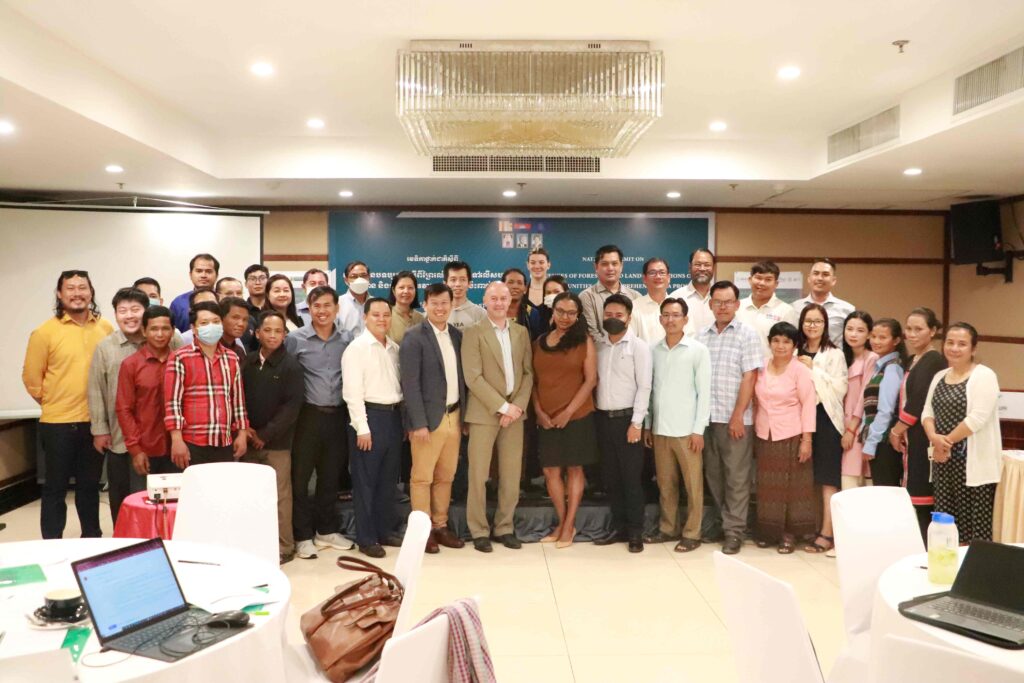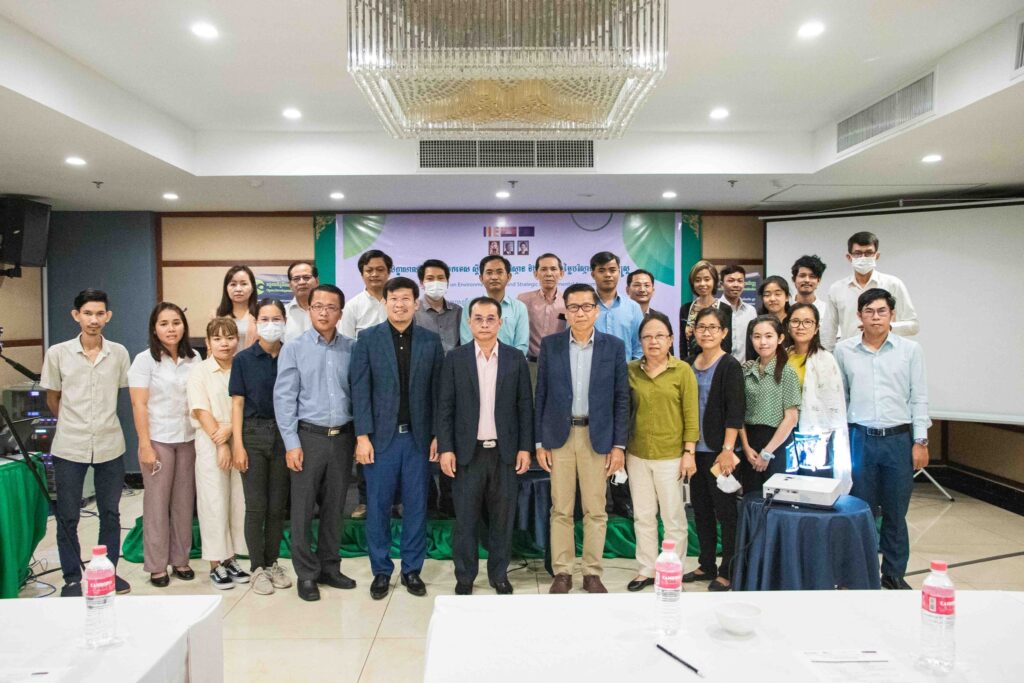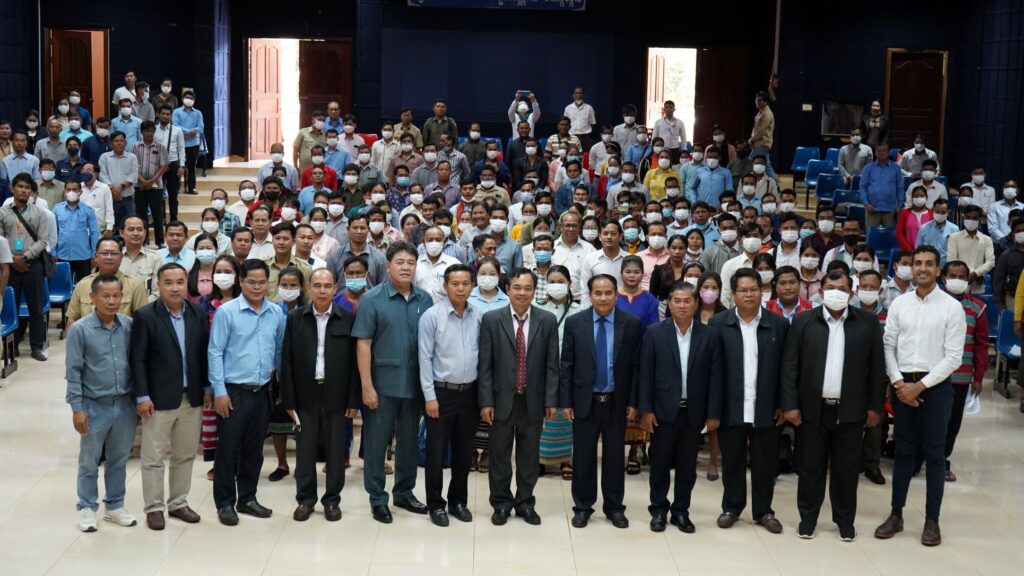The 42nd Annual Conference of the International Association for Impact Assessment
From 08 – 11 May 2023, Open Development Cambodia (ODC) attended the 42nd Annual Conference of the International Association for Impact Assessment under the theme of “Resilience through impact assessment and leadership” at Kuching, Malaysia. As part of the partnership on technical assistance for developing SEA guidelines in Cambodia, ODC also supported two government officials from the Department of Environmental Impact Assessment, Ministry of Environment, in attending the conference. The conference aimed to establish a path to resilience through impact assessment and leadership by organizing presentations on contextual applications and conceptual advances of impact assessment. There are 70 sessions focusing on two main streams: thematic sessions on “resilience through impact assessment and leadership” and general impact assessment sessions. On 08 May 2023, the program officially started with an opening plenary, seven concurrent sessions, a poster session, and a welcome reception. Similarly, there were nineteen concurrent sessions, six sessions on the theme forum, and other networking/meeting activities on the conference’s second day. The next day, three sessions focused on the theme forums, and nineteen sessions were concurrent. ODC also hosted a panel discussion on “Strategic environmental assessments (SEA) in Mekong country” to explore the considerations in policy, program, and plan on SEA in Mekong country. Twenty-one experts (08 females), including representatives from the EIA department of the Ministry of Environment in Cambodia and SEA and environmental law experts, joined the discussion to share their experiences and insights on SEA progress, development, and best practices in the region. The last day of the conference mainly consisted of three sessions for the theme forum, thirteen concurrent sessions, committee meetings, a closing plenary, and exhibit and poster dismantle. During the conference, the ODC team and the two government officials from the EIA Department participated in more than thirty sessions to learn, discuss, and share experiences on impact assessment and leadership across the region. This participation also allowed us to meet more than 600 global experts to explore their perceptions of nations’ interests, sustainable development, indigenous rights, and preservation of biodiversity. It can benefit the consideration to apply in Cambodia to establish a path to resilience through impact assessment and leadership. Below are some speeches by ODC team after attending IAIA23: Mr. Thy Try, Executive Director/Editor-in-Chief of ODC: Attending IAIA23 in Kuching was an incredible experience, reconnecting with experts in impact assessment and leadership. It was my second time attending an IAIA conference in person, with my first experience being in Florence back in 2015. The event in Kuching once again showcased the resilience needed in our SEA and EIA field, and I am truly looking forward to the next IAIA conference in Dublin in 2024, where new insights and opportunities await. Ms. Kuoch Layheng, Economics Editor – Researcher of ODC: IAIA23 was an amazing first-time experience for me. Meeting, discussing, learning, and sharing experiences with many experts across the globe was an excellent opportunity for the team and me since we could consider using it to apply in Cambodia’s context. Mrs. Koem Chhuonvuoch, Natural Resource and Land Editor – Researcher / Project Coordinator of ODC: IAIA23 on resilience through impact assessment and leadership provided me with a wide range of knowledge and experiences with experts in various fields. We got to see what’s going on and how they handle impact assessment around the world.
Strategic environmental assessment in Mekong countries
Open Development Cambodia (ODC) was thrilled to host a panel discussion on “Strategic environmental assessment (SEA) in Mekong countries” at the 42nd Annual Conference of the International Association for Impact Assessment: Resilience through impact assessment and Leadership on 10th May 2023 at Borneo Convention Centre Kuching, Kuching, Malaysia. Representatives from Cambodia’s Ministry of Environment’s EIA department, SEA, and environmental law experts participated in our discussion to share their experiences and insights on SEA progress, development, and best practices in the region. Mr. THY Try, ODC’s Executive Director, started the discussion by explaining what ODC is and what we are working on. The discussion will provide an update on the progress and development of SEA in Cambodia and opportunities to learn from experts in the field. During the session, three important questions were discussed: the current legal framework, key research gaps and priorities for advancing SEA, international cooperation and knowledge sharing, and opportunities and challenges to SEA development and implementation in Mekong countries. Because there are still limitations in environmental impact assessments (EIA) that have been used to evaluate the impact of investment projects on the environment, the establishment and implementation of SEA are required for significant investment. EIA also has varying effects on the projects. Cambodia’s development and economy have benefited greatly from investment inflows. Aside from the contribution to the country’s growth rate, the environmental impacts can be seen at both the micro and macro levels, which should be carefully considered. The micro level focuses on the correlations between the attraction of investment by firms and the cost of the environment, whereas the macro level focuses on the government’s and international community’s concern about whether foreign investment will degrade the ecological environment of host countries or not. The Law on Environmental Protection and Natural Resource Management, the National Environmental Strategy and Action Plan (2016-2023), Sub-decree No. 72 on the EIA Process, and the Environmental and Natural Resources Code are all SEA-related regulations in Cambodia. The code could make SEA a requirement for strategic planning in a variety of industries. The process of preparing a SEA report must take special consideration and provide opportunities for vulnerable people, ethnic minority groups, and indigenous peoples to participate. The monitoring results will be made available to all ministries and institutions, as well as the general public. Although the SEA process was initiated in the late 1980s by high-income countries such as the United States and European states, this tool is receiving increasing attention in the Greater Mekong sub-region. In Cambodia, the SEA initiative was only launched in the mid-2010s, with the publication of some pilot industry-specific reports, such as one on sustainable tourism. The SEA of Cambodia’s strategic planning framework for fisheries 2010-2024 was also published as a result of the development partner’s commitment. The Cambodian SEA path, like that of other countries, began with an emphasis on EIA. Currently, ODC is assisting the Ministry of Environment’s Department of EIA in developing the SEA guideline. The department highlighted the development of the SEA technical guideline and the SEA on sand mining in Cambodia. Based on the discussion during the session, the guidelines will be conducted within the next three years based on the timeframe provided. This is an important step towards ensuring that our natural resources are used sustainably. The experts have concerned with the management plan and responsibilities of the SEA’s lead agency. It would be sustainable if the SEA’s leadership is the line ministry. Because SEA and EIA are not the same things, and each SEA report is unique, stakeholders must be trained and experienced in SEA practice. Cambodia should make an effort to develop this policy because its role is critical and it has many opportunities and value in the ASEAN region. We applaud the ministry’s commitment to promoting environmentally responsible practices and eagerly await the results of this SEA. During the discussion, the participants also shared updates and the progress of the SEA implementation in Mekong countries.
National summit on influences of forestry and land regulations on local communities and comprehensive EIA process
Open Development Cambodia (ODC) organized a national summit on “Influences of Forestry and Land Regulations on Local Communities and Comprehensive EIA Process” on 25 May 2023 with a total of 43 (13 females) representatives from the Ministry of Rural Development (MRD), CSOs, EIA firm, journalists, and indigenous peoples from Ratanakiri, Mondulkiri, Kratie, Pursat, Stung Treng, Preah Vihear, and Kampong Thom provinces. The event was supported by the United States Agency for International Development (USAID) through Family Health International (FHI 360) under the Civil Society Support Activity: Cluster Anchor Grants, and Heinrich Böll Stiftung Cambodia (HBS) under the project of promoting EIA for more transparent and responsive environmental governance in Cambodia. The national summit aims to: Provide an opportunity for relevant stakeholders to express their concerns regarding existing and proposed forestry and land law and associated regulations Identify the effective strategy to provide input into the draft laws Discuss how the proposed law and associated regulations will interact with the EIA process, particularly the engagement of local communities and the public more broadly. The team invited Mr. IL Oeur, Executive Director of Analyzing Development Issues Centre (ADIC), and Ms. YA Yanny, a representative of indigenous women from Mondulkiri province to be the speakers. Mr. THY Try, Executive Director of ODC was the moderator of the panel discussion on “Forestry and land regulations”. The discussion started by introducing the speakers as well as their work. Analyzing Development Issues Centre (ADIC) shared their research on public participation in Prey Preah Roka Wildlife Sanctuary and Chhaeb district, Preah Vihear province. The Ministry of Environment (MoE) had clear guidelines and engaged the local community in the process. They set up numerous local and national meetings for two years to map the areas. This is the first map that engages many people, so there are no concerns raised by the local community during the mapping process. The concern is that when the map is released, who will be responsible for border demarcation? The land inventory is also significant to identify the specific land that each indigenous people own within the communal land title. Then questions were raised around the differences in duration of the indigenous communal land titling and private land title as well as the word usage in the law. A representative from the Cambodia Indigenous Peoples Organization (CIPO) shared the concern on the indigenous community cannot do the rotation or traditional agriculture unless they have been registered. That’s a critical point if the community grows the crop or rice on the land. A response from the MRD, if the community has been recognized as an indigenous group by the ministry, there should not be a problem to use the land. The representative from CIPO also mentioned the concern about excluding the word “Indigenous peoples” in the draft law. Indigenous peoples would like to keep their identity (differentiate from other people) both in the current and upcoming laws. Regarding the input, we would like to see a separate chapter talking about the indigenous people within the Land Law. The discussion between the CSOs and indigenous peoples should be happened before meeting with the related ministries to share their concerns to address in the draft law. The discussion around the reasons for revising or amending the law should be widely disseminated. The government should open for consultation with practical and concerned stakeholders. A representative from 3SPN stated that the draft EIA law excludes the word “FPIC” meaning free, prior, and informed consent. The law encourages to have full public participation in all areas. Fully participation has a different definition from FPIC which considered accessing the information, participation, and decision-making. The participants highlighted that cooperation and working together among key CSOs is very important. By doing so, we could enforce and coordinate the mechanism and inputs effectively. There is an interesting question from the private company regarding indigenous peoples’ economic, livelihood, and materials trends. The question has attacked the attention of indigenous peoples in the rooms to share where they are now. They said, \"Some people get a larger house and modern materials, but some of them have to pay back the loan every month. Some people are poor and do not even have a small area of land to grow crops. What we are now cannot be compared with what we have lost. Although we need to adapt to the modern era, we would not want to lose what we used to have, especially the culture.\" In brief, we discussed the inputs which also reflect several significant points including cooperation among key stakeholders and CSOs in the input gathering and providing to the policy-makers as well as networking with the related ministries, case studies in Mondulkiri, Ratanakiri, and Preah Vihear, and the word usage in the law. The panel discussion on “EIA process: Public participation” brought together Mr. HORM Kimkong, Director of Environmental and Assessment (E&A) Consultancy, Mrs. TEP Tim, a representative of indigenous women from Preah Vihear province, Mr. LEANG Bunleap, Executive Director of 3S Rivers Protection Network (3SPN). The discussion was moderated by Mr. LONN Pichdara, Executive Director of MyVillage Cambodia. Mrs. TEP Tim living in Prame commune, Tbaeng Mean Chey district, Preah Vihear province, said that she did not get an invitation to join the public participation of the EIA process as well informed about the development project beforehand. So far, they only invited the commune and district councils to the meeting. A representative from 3SPN stated that public participation sometimes could provide the opportunity for the company to only gather the people who agree and support the project. The law or regulation on public participation is very important, and it should clearly state who should be invited to join such as from the beginning of the process. “When we are discussing the Land Law, it should also refer to the Cambodian people as well. Why the discussion this morning was focusing on indigenous peoples only?” Question from our participant. Yes, it should be referring to everyone. However, we would like to pay more attention to the indigenous peoples because they are the most vulnerable group among others. From time to time, they live and survive in the forest and do not have any land titles as we do. When there is a development project, they always eye on the forest areas where there are not many people living there. In the case of Cambodia, some projects just process the EIA after a long-term operation. The participants wonder what is the point behind that. EIA is just a tool to assess the impact, not a law. There are three types of EIA implementation including EIA before, during, and after the project implementations. The companies that were established a long time ago do not have EIA since it did not exist at that time. As a result, the MoE review and request them to do the EIA. The new development projects currently must have done the EIA before implementing the project based on the guideline of the ministry. EIA report is very difficult to get. How could we get the EIA reports? Normally, when the report is approved, the consultant, project owner, and the MoE have to stamp each page of the report. Previously, the consultant has to prepare 12 copies, but currently, there are only six copies required which will be kept by the consultant (1), the project owner (1), and the rest will be kept by the EIA Department. The consultant needs to keep the report in a safe place for 3 or 5 years based on the agreement, and they cannot share the report without permission from the project owner. The report could be officially requested from the MoE. Our speakers also suggested the community and CSOs keep all the related documents they provided during public participation. The discussion and content of the provided documents will not have much difference from the approved EIA report. Additionally, the stakeholders should focus on the EIA training for the local community so that they could understand the process as well as the content of the report.
Indigenous peoples sectoral advisory meeting
On 08 February 2023, ODC organized the “Indigenous Peoples Sectoral Advisory Meeting” with the partners, including Conserve Indigenous Peoples Languages Organization, MyVillage Cambodia - MVi អង្គការ ភូមិខ្ញុំ, Forests and Livelihood Organization FLO, Cambodia Indigenous Youth Association-CIYA, and FHI 360 to identify the challenges, activities, roles of the group, and call for new members. The project is funded by USAID Cambodia through FHI 360 under Cluster Anchor Grant from the Civil Society Support (CSS) Project.
Environmental data and strategic environmental assessment (SEA)
Phnom Penh, 03rd November 2022, Open Development Cambodia (ODC) hosted a Technical Workshop on Environmental Data and Strategic Environmental Assessment (SEA). This workshop was supported by the United States Agency for International Development (USAID) through Family Health International (FHI 360) under Cluster Anchor Grant from the Civil Society Support (CSS) Project and Heinrich Böll Stiftung (HBS) under Promoting Environmental Impact Assessment (EIA) for a more Transparent and Responsive Environmental Governance in Cambodia Project. The workshop aims to: Raise awareness of the SEA among CSOs, citizen journalists, indigenous people, and researchers. Discuss and share the current statue of the SEA in Cambodia Identify the potential of integrating SEA and its implication in environmental and natural resource management. The event brought together 32 participants (11 females) from the Ministry of Planning (MoP), World Wide Fund for Nature (WWF), Wildlife Conservation Society (WCS), Family Health International (FHI 360), other international and local non-governmental organizations (NGOs), community-based organizations (CBOs), journalists, researchers, and indigenous peoples (IPs). Environmental Impact Assessment (EIA) and Strategic Environmental Assessment (SEA) Mr. THY Try, Executive Director/Editor-in-Chief of Open Development Cambodia, and Mr. MATHEW Baird, Director of the Asian Research Institute for Environmental Law, have highlighted the differences between EIA and SEA as well as some procedures of SEA. Development projects typically promote economic development, but they should not neglect or ignore the impact on the environment and society. SEA incorporates environmental considerations into policies, plans, and programs (PPP). SEA is used to estimate and evaluate the consequences of specific development PPP. It means that the project is not there yet. The government will decide whether the project could be implemented or invested in that area. It usually happens before doing the EIA. In contrast to the commonly used EIA, which occurs after the decision-making process, SEA occurs before all important decisions, which offers significant advantages. It was initially promoted to fill gaps in project-based EIA due to the limitation of EIA to address the environmental policy integration at the strategic levels, particularly during policy and plan-making. The capacity of EIA to account for the strategic consequences of subsequent projects in a single area is limited. As a multi-stage process focusing on overall sustainability, SEA takes a proactive approach to all development activities, identifying key obstacles before final approval. Public participation is the key point, and it must be included in both SEA and EIA processes. EIA and SEA complement each other. It does not mean that we can ignore one of them. Mr. THY Try also demonstrated a video about the UNECE SEA Protocol, which was created by the United Nations Economic Commission for Europe (UNECE) as part of the EU-funded program “Greening the Economies in the European Neighborhood.” The protocol establishes clear and transparent procedures for incorporating environmental and health concerns into national development plans, programs, and legislation. Spatial Plan and its Integrated Landscape Approach Mr. SENG Teak, Country Director of the World Wide Fund for Nature (WWF), presented one of the significant implementations called the “Mondulkiri Provincial Spatial Plan.” He highlighted the 2040 scenario-based analysis for the province divided into three scenarios: conservation, green economy, and business-as-usual. The first scenario, “conservation,” could keep the forest cover in Mondulkiri up to 85% by mainly protecting all forests inside and outside the protected areas (PA) and using non-forest areas for agricultural and development areas. The second scenario, “green economy,” only protects the forest in the PA, whereas the forest outside the PA and non-forest areas are used for agricultural development areas. By doing so, the forest cover in the provide will remind 53% by 2040. In the last scenario, “business-as-usual” will not enforce forest protection, and the forest cover will remain at only 34%. In brief, the second scenario is used for the spatial plan for Mondulkiri and will be adopted shortly. The spatial plan is critical because it has the potential to provide effective development principles and tools for informed decision-making and spatial development processes to promote balanced territorial development. The planning could be done by following significant steps, including establishing a multi-stakeholder platform, building a shared understanding, collaborative planning, implementing, monitoring for adaptive management and accountability, and shaping the context. The potential of SEA Integration and its Implication on Natural Resource Management H.E. NOR Vanndy, Director of the Economic Statistics Department, National Institute of Statistics, Ministry of Planning (MoP), and Mr. TEP Sakmakara, Deputy Chief of Office of the Department of Economic Statistics, MoP, highlighted how the ministry addresses the environmental data and issues in the development plan. Integration of environmental issues in the development plan is the initial stage, and the country should do it. Environmental issues are considered to include in long-term and medium-term development plans such as National Strategic Development Plan (NSDP) and Sector Development Plan. It was observed that the integration of the environmental issues in the previous NSDP (2014-2018) is less and not paid much attention. Therefore, the government has considered and added more environmental issues to the new NSDP (2019-2023). Chapter 4 (4.42) of the NSDP (2019-2023) “Promote the inclusion of strategic environmental assessments in the decision-making process, policies, plans, and legal documents to ensure the sustainability of the environment and natural resources.”
Land and natural resource governance
Open Development Cambodia (ODC) under the Civil Society Support Activity: Cluster Anchor Grants funded by United States Agency for International Development (USAID) through Family Health International (FHI 360) supported indigenous peoples to participate in the Conference on Land and Natural Resource Governance which was organized by the NGO Forum on Cambodia in Ratanakiri province on 12th - 13th October 2022. The conference aims to engage with the Royal Government of Cambodia to advance laws and policies related to land and natural resources and to strengthen the implementation of policies, laws, and regulations that are meant to promote land and natural resource governance with a focus on addressing social impacts and protecting natural resources and the environment, as well as the sustainable livelihoods of local communities. The event was divided into two phases, which began with gathering input from over a hundred local communities, indigenous communities, community protected areas, forestry communities, and local non-governmental organizations (NGOs). The inputs were used for the panel discussion with the representatives of Ratanakiri, Stung Treng, Kratie, Preah Vihear, Mondulkiri, and Kampong Thom Provincial Governors, Ministry of Interior (MoI), Provincial Departments of Agriculture, Forestry and Fisheries, Provincial Departments of Environment, Provincial Department of Land Management, Urban Planning, and Construction, Provincial Departments of Rural Development, Provincial Departments of Mines and Energy, and private sectors on the second day with a total of 250 people (60 females) participated. Land and natural resource governor in Ratanakiri province Economic land concession within the province is granted to 27 companies, of which 10 companies justified the contract, 06 companies are in the process of revising, and 11 companies have not signed the contracts. The business area is 83,785 hectares, with a total investment area of 181,896 hectares. The area that has been cleared is 56,702 hectares, and the cultivated area is 51,067 hectares. There are 75 indigenous communities recognized by the Ministry of Rural Development, while 85 communities have been recognized as legal entities by the Ministry of Interior. However, only 24 indigenous communities received communal land titles from the Ministry of Land Management, Urban Planning, and Construction. Systematic land registration achieved 15,691 titles which is equivalent to 10,741 families. Two villages have finished the public announcement, while a village is in progress. Two public announcements on the communal land titling are finished and requesting reclassification for three communities. There are 11 community-protected areas and 36 community forestry, of which 22 have been registered with the Ministry of Agriculture, Forestry and Fishery (MAFF). There are 14 community fisheries, and all of them have been recognized while two new communities have been established. Recognize and protect customary land tenure The community and civil society organizations have identified key challenges to recognizing and protecting customary land tenure. Land that has received the land title or is in processing is not yet secured, and the process is complicated, time-consuming, and costly. The approved land classification does not correspond to actual practice and occasionally overlaps with protected areas because management areas have not been clearly divided. Despite the fact that the land has been registered, indigenous peoples continue to face land grabbing and deforestation. According to the community, the forest crime crackdown is still limited and ineffective. The community committee\'s capacity and knowledge are limited and need to be expanded in terms of by-laws and internal rules, while the community\'s livelihood and natural resource conservation must be improved. To address the issues, the communities would like to see strong collaboration between communities and local authorities to strengthen law enforcement with the assistance of district and provincial administrations. The network of community forestry should be established from the national to the commune level. The process of titling communal land should be improved, and the government should provide an annual budget for each community to manage the land and forest while also improving their standard of living. The budget could be used as a community loan for each member. Yet, the results of the suggestions cannot be confirmed.
- « Previous
- 1
- 2
- 3
- Next »
